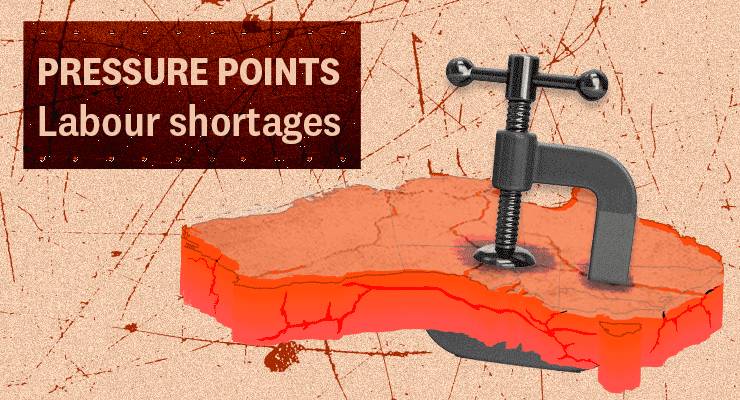
We’ve all heard stories of restaurants unable to reopen due to lack of staff. Or reports of consulting firms advertising thousands of vacant jobs. As Australia emerges from lockdowns, labour shortages have been a serious concern for businesses across the country.
Based on the mid-year budget update released yesterday, the government expects the labour market to tighten significantly: MYEFO predicted that unemployment will fall to 4.25% in coming years. Crucially, it sees participation as remaining at historically high levels — 66% and above — into the mid-2020s. On the basis of this jobs boom, the government is expecting a big tax haul that will allow for even bigger spending.
But the government’s prediction of massive jobs growth relies on some crucial assumptions, including that the right people with the right skills are available to fill these jobs. And with so many uncertain factors impacting labour, it’s anyone’s guess what will happen next.
Why are there shortages?
Countless factors are causing shortages in different industries, but all signs point to COVID. Border closures have prevented migrant workers from entering Australia. Lockdowns have led to resignations in industries that became unreliable such as hospitality and tourism. Certain industries, such as consulting and legal practice, have had labour shortages based on booming business resulting from Australia’s economic recovery. In that instance, so much work is coming through the door that firms are finding it difficult to hire enough people to meet demand.
But the long predicted “great resignation” didn’t eventuate in the way experts expected. There is evidence of post-COVID career hopping, which saw 26% more company movement than in the same period in 2019. These movements are exacerbating experiences of labour shortages in the short term, but predicting human behaviour is tricky business. And if it turns out COVID is not as “over” as we hope, ramifications for the labour market will be ongoing.
What’s being done?
The government expects that a massive influx of migrants will address much of the labour shortage: it has doubled its forecast of net migration for next financial year and sees over 200,000 people entering Australia on a net basis each year through to 2025. International students, who provide hundreds of thousands of workers for low-skill jobs, are on their way back, though it’s yet to be seen how many will return and how quickly. The government’s assumption that COVID is sorted and borders will never close again could yet prove optimistic.
But unusually, even business groups are admitting that opening the doors to temporary migrants won’t solve everything — Australia will have to compete with other countries for skilled workers, and with other higher education systems for foreign students. Employer groups are calling for more upskilling and training — though that’s a longer-term fix.
In the shorter term, reports suggest businesses have been offering pay rises and other incentives in attempts to hold on to staff, including in unskilled positions. But with the ever-present threat of a serious resurgence of COVID, inventive policy solutions may be needed to address the issue domestically in the longer term.
And maybe it’s time for a broader reflection. As Crikey has reported, wages have been stagnant for years now, as the cost of living grows at a rapid rate. With labour retention being an ongoing issue, employers should be collectively contemplating taking the plunge and further investing in their workers.








Unions achieve pay rises. Or, they used to do, before Howard won his war against them. Imported tradespeople are cheaper than training apprentices, so not enough Aussie tradespeople. It may be Lib heaven, but the economy is predictably less fit for purpose than it used to be. It needs turning around, along lines favouring some equality. Casual workers on low hours, one year contracts, etc, etc. It should go without saying that people need security and self respect, but it seems to be forgotten.
Think you nailed it, classic old Tory or now ‘radical right libertarian’ Kochonomics channeled by the IPA etc. from HOward’s time to nobble and neuter unions, wages, award conditions, workplace access (media access too), then using old eugenics trope, blame undefined immigration and population growth for unemployment and environmental ‘hygiene’ issues.
Result? Australians, all of immigrant stock, shouting at other more recent immigrants; divide and rule, or as Mike Moore of Frontline said ‘divide the electorate and multiply the vote’.
What constitutes a skilled worker?I have seen reports where baristas are classed as skilled workers.How long would it take to train someone to be a barista?
From casual observation of the species in its natural habitat, overpriced poncey pop-ups, about 10mins should suffice.
Tops.
“…employers should be collectively contemplating taking the plunge and further investing in their workers.”
That’s one element. I suppose the article, despite being about skilled labour shortages, says nothing about higher education (except for migrant students) or about TAFE colleges because everything there is already as good as could be for turning out skilled Australians.
So more “skilled” engineers and scientists to work on packing lines? Yes, there are plenty, regardless of what you hear from I.E. Aust. All waiting to be able to bring their aging relatives out. How does that benefit Australia?
Never is there a comment regarding the required improvements to supporting infrastructure when migration is mentioned.
No, the “skilled” migrants with more master degrees and doctorates in engineering are still driving taxis around the streets of Canberra near were I live as seems they can’t pass the mustard with august bodies like Engineers Australia, but the question should fall back to the federal government knowing full well they would face a hurdle getting professional recognition in this country.
Good to see someone trying to analyse the workforce and employment in a realistic way into the future versus most media shouting at headlines…. while having no insight and avoiding any informed input form e.g. unions and even employers….
There are a few dynamic (not static) factors operating, that fly under the radar in Oz media i.e. our long term permanent population of citizens or PRs (excluding the NOM temporary churnover) is ageing with higher dependency ratios i.e. more oldies tugging on budgets with a commensurate decline in working age population cohort (see OECD); the churn over of temporaries as net financial contributors helps support budgets, maybe marginally cover some low/mid skill gaps and are later replaced by others.
Presently, Australia is in the middle of our baby boomer ‘bubble’ transitioning to retirement; these are a very serious number of workforce exits occurring over next decades….. not just replacing workers or robots with automation and the same, but many are highly skilled and scarce professionals and tradespeople.
As the article suggests, vs. media and punters’ preference for headline data and big statements, better analysis is drilling into sectors, occupations, postcodes etc. and numbers, as some sectors are huge e.g. registered nursing alone is almost 300K (most people underestimate the size of our workforce so e.g. several hundred potential ‘migrant’ workers seems a lot).
Meanwhile, fresh input into occupational workforces is modest when balanced out with now increasing workforce departures (with low fertility generations following), leaving skill shortages, too often in regions and/or specific occupations (see JobOutlook -> Career -> FutureOutlook gives much occupation detail).